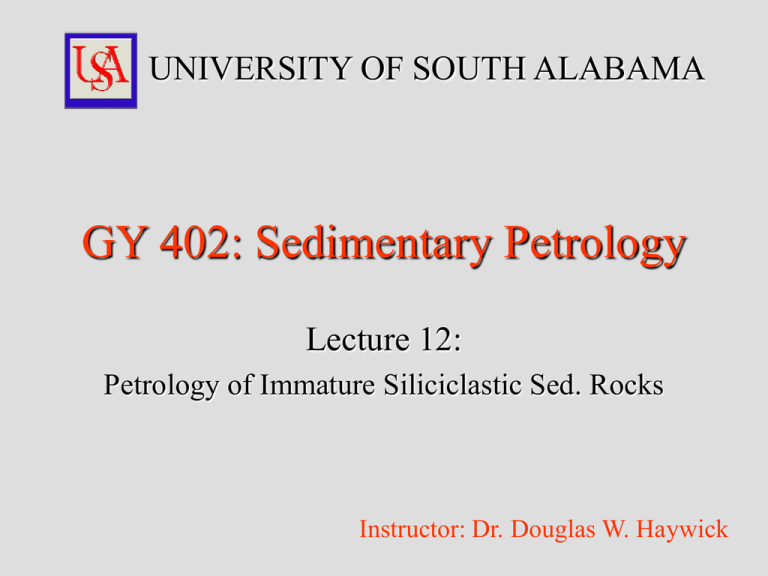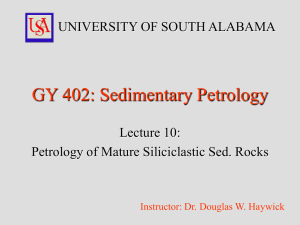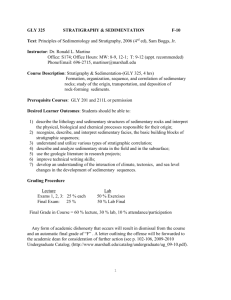GY 402: Sedimentary Petrology UNIVERSITY OF SOUTH ALABAMA Lecture 12:
advertisement

UNIVERSITY OF SOUTH ALABAMA GY 402: Sedimentary Petrology Lecture 12: Petrology of Immature Siliciclastic Sed. Rocks Instructor: Dr. Douglas W. Haywick Last Time 1. Factors promoting beach development 2. Beach profiles 3. Beach facies & sedimentary sections Beach Facies From Walker, R.G. and James, N.P. (1992). Facies Models: Response to Sea Level Change. Geological Association of Canada, 409p. Factors controlling beach development Steady supply of sand to the shoreline, by river, delta or longshore drift Wave dominated setting (medium to high wave energy is best; low tidal energy necessary) Stable, low gradient coastal plan and continental shelf gradient 32,000 km of shoreline meet these requirements; best studied beaches are along the US eastern and Gulf coasts Overall beach dynamics From Walker, R.G. and James, N.P. (1992). Facies Models: Response to Sea Level Change. Geological Association of Canada, 409p. Hydrodynamic zones Sedimentary Facies From Komar, P.D., 1998. Beach Processes and Sedimentation. Prentice Hall, New Jersey, 544p. Beach Facies From Walker, R.G. and James, N.P. (1992). Facies Models: Response to Sea Level Change. Geological Association of Canada, 409p. Today’s Agenda Immature siliciclastic sediment and sedimentary rocks 1. Immature siliciclastic sediment 2. Immature siliciclastic sedimentary rocks 3. Point counting (an option for bonus credit in this week’s lab assignment) Siliciclastic Sedimentary Rocks Q Q = quartz F = feldspars R = lithic fragments (includes chert) F R Source: Blatt, H., Middleton, G and Murray, R., 1980: Origin of Sedimentary Rocks. Prentice Hill, 782 p. Siliciclastic Sedimentary Rocks Q “Mature” rocks (mineralogically stable) Enriched in quartz and clay minerals F R Source: Blatt, H., Middleton, G and Murray, R., 1980: Origin of Sedimentary Rocks. Prentice Hill, 782 p. Mature Siliciclastic Petrography Quartz-rich (quartz arenites) Generally well rounded grains Poorly sorted to well sorted Gravel to clay sized grains XN 250 m Siliciclastic Sedimentary Rocks Q “Immature” rocks (mineralogically unstable) Enriched in feldspars and unstable rock fragments F R Source: Blatt, H., Middleton, G and Murray, R., 1980: Origin of Sedimentary Rocks. Prentice Hill, 782 p. Important Grain Parameters Important Grain Parameters Grain Size (energy of deposition) Rounding (degree of wear) Sorting (energy of deposition) Immature Siliciclastic Sediment Immature Siliciclastic Sediment PPL 250 μm XN 250 μm Immature Siliciclastic Sediment Is usually more diverse (mineralogy-wise) than mature sediment. Grains include: XN 250 μm Immature Siliciclastic Sediment Is usually more diverse (mineralogy-wise) than mature sediment. Grains include: Plagioclase feldspar Orthoclase Microcline Micas Lithics Quartz XN 250 μm Immature Siliciclastic Sediment More variable grain compositions can make mineral identification more difficult Immature Siliciclastic Sediment More variable grain compositions can make mineral identification more difficult e.g., orthoclase and quartz (look for chemical alteration of feldspar) Immature Siliciclastic Sediment Cement/matrix is also typically more variable (and complex!) Matrix versus Cement Matrix Cement • Heterogeneous • Chemically impure • Drapes over grains • Predates cements • Generally dark in color • Homogeneous • Chemically pure • Lines pores • Specific fabrics • Multiphased, zoned 100 µm XN 100 µm Matrix versus Cement Matrix Cement • Heterogeneous • Chemically impure • Drapes over grains • Predates cements • Generally dark in color • Homogeneous • Chemically pure • Lines pores • Specific fabrics • Multiphased, zoned Clay cement is hard to distinguish from matrix PPL 100 µm http://www.earthsci.unibe.ch/bilder/exogenegeologie/fig_7am.jpg Matrix versus Cement Matrix Cement • Heterogeneous • Chemically impure • Drapes over grains • Predates cements • Generally dark in color • Homogeneous • Chemically pure • Lines pores • Specific fabrics • Multiphased, zoned Squished fine-grained lithic clasts are hard to tell apart from matrix PPL 150 µm Lithic Fragments Lithic Fragments Hand specimens Imature siliciclastic sandstones (arkose - litharenite) Arkose (basalt-derived) Litharenite (igneous/sedimentaryderived) 5 cm Arkose (granite-derived) Thin-section Photomicrographs Arkose ppl xn 1.5 mm Thin-section Photomicrographs Arkose quartz plagioclase chert ppl xn 1.5 mm Thin-section Photomicrographs Arkose ppl xn 0.5 mm Thin-section Photomicrographs Arkose microcline Granite rock fragment “perthite” ppl xn 0.5 mm Thin-section Photomicrographs Arkose ppl xn 750 m Thin-section Photomicrographs Arkose plagioclase ppl xn 750 m Thin-section Photomicrographs Arkose ppl xn 1 mm Thin-section Photomicrographs Arkose biotite ? ppl xn 1 mm Thin-section Photomicrographs Litharenite ppl xn 0.75 mm Thin-section Photomicrographs Litharenite chert muscovite chert volcanic R.F. ppl xn 0.75 mm Thin-section Photomicrographs Litharenite ppl 0.250 mm Thin-section Photomicrographs Litharenite ppl xn 750 μm Thin-section Photomicrographs Litharenite chert chert ppl xn 750 μm Thin-section Photomicrographs Arkose - cement ppl xn 1 mm Thin-section Photomicrographs Arkose - cement calcite cement ppl xn 1 mm Thin-section Photomicrographs Arkose - cement dolomite cement ppl xn 0.75 mm Mechanical stage Mechanical stage Point counting The mechanical stage locks the thin section down to the stage. You systematically advance the thin section along the x or y directions. At each stop, you identify the grain/component under the cross-hairs. Point counting Point counting x - direction Point counting x - direction Point counting x - direction 300 point counts (minimum) are required in order to assure statistical significance Upcoming Stuff Homework 1) Grain size projects Next Monday (revised) Lab This Week Immature Siliciclastic Petrography (Due Thursday) Online Lecture: Lecture 14-Immature Siliciclastic Facies This Thursday: Activity 5: Flume exercise (fun!) More Today’s Lab Today’s Lab Today’s Lab Today’s Lab Do one thin section from Group 1 and one from Group 2, 3 or 4 GY 402: Sedimentary Petrology Lecture 12: Immature Siliciclastic Sedimentary Rocks Instructor: Dr. Doug Haywick dhaywick@southalabama.edu This is a free open access lecture, but not for commercial purposes. For personal use only.






